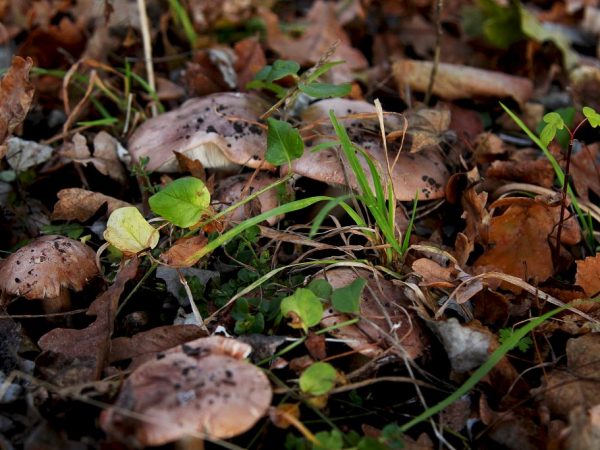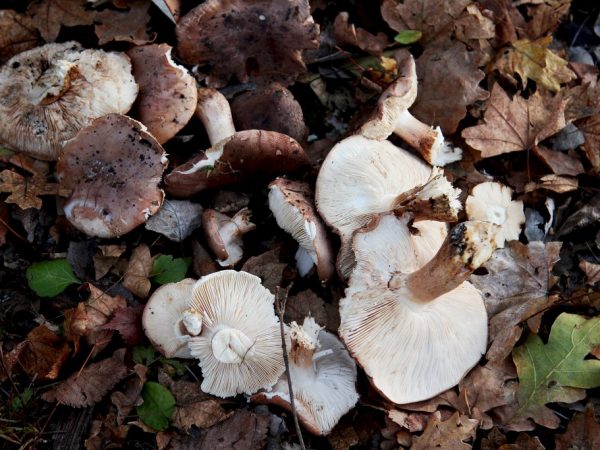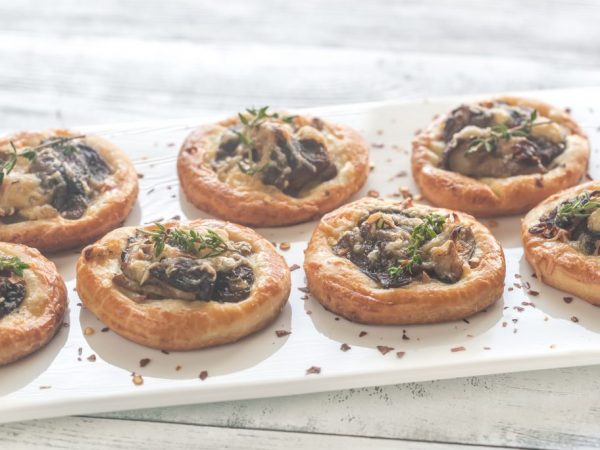Description of the mushroom ryadovka white-brown
Among the little-known mushrooms in Russia and Europe, there is a white-brown ryadovka. It grows in groups in coniferous forest and pine forest. The mushroom is considered late. It is harvested from August to the 2nd half of October.

Description of the mushroom ryadovka white-brown
The appearance of the mushroom
the fungus Tricholoma albobrunneum belongs to the lamellar, family Row or Tricholomaceae. Its other names:
- The row is brown;
- the row is white-brown;
- lashanka (Belarusian version of the name).
The white-brown ryadovka is an active mycorrhizal forming agent with pine. Fruiting from August to October.
Hat
The hat reaches 4-10 cm in diameter. Its edges are rolled down. The shade ranges from brownish red to chestnut or reddish gray.
Young fruiting bodies are distinguished by a hemispherical cap shape. In ripe ones, it becomes convex, prostrate. A tubercle is always present in the middle.
The surface is fibrous, cracks as it grows, scales appear. Most cracks occur in the center.
It is important to be able to distinguish this species from the fibrous-scaly row. The latter has a flaky cap, dullness. No stickiness during rain.
Leg
A leg with a diameter of 0.5-2 cm can grow up to 7-8 cm.Under favorable conditions, it reaches 10 cm. The leg of the cap is even, but towards the base it becomes longitudinally fibrous. Its outer structure creates a scaly effect.
Similarly to the fibers, the color of the leg changes. From top to bottom, it ranges from white and light beige to gray-brown. The lower half of the leg of a young mushroom is a brown, cylindrical row, of a mature one - narrowed, hollow.
By the leg, the mushroom is distinguished from the related species of the yellow-brown ryadovka. The "sister" has a thin film ring.
Pulp
The color depends on the climate of the place of growth:
- White: is the result of sufficient moisture.
- Brown blotches: appear only in the dry season.
The plates are white with red spots, partially adherent. Disputes are subtle, transparent white, ellipsoidal.
The pulp does not have a pungent odor. A mealy aroma is sometimes felt. The taste gives off a little bitterness.
Edibility
The row is white-brown conditionally edible due to the presence of bitterness. Fruit bodies cause poisoning in the absence or insufficient heat treatment.
Attention! The maturity of this tricholoma also affects edibility. The younger the mushroom, the safer it is.
Irina Selyutina (Biologist):
Different sources give different information about the edibility of the white-brown row. Some call it an edible mushroom, others consider it conditionally edible or even send it to inedible species. Officially, the white-brown ryadovka is ranked among conditionally edible mushrooms and belongs to the 4th category in terms of taste. In this regard, it requires a preliminary long boiling. With a short heat treatment time, lashanka can cause mild poisoning.Therefore, for safety, it is better to take only young specimens into the basket, but large ones are adults should be left in the forest.
The edible ryadovka has a weakly poisonous twin - the spotted ryadovka. She is recognized by the dark spots on the hat. The blotches are located around the circumference or cross the cap in diameter.
A dangerous species is recognized by the absence of a tubercle in the center of the cap and a pronounced bitter taste.
Beneficial features

It is important to cook mushrooms properly
If the white-brown row is properly prepared, it retains all the beneficial nutrients inherent in it, the composition of which includes:
- protein: high content (4%), easily digestible;
- amino acids: important for human metabolism;
- trace elements: a large amount of magnesium, zinc;
- vitamins D, C, A, B1, B6, B12.
The cooking method affects the calorie content of tricholoma. Boiled fruit bodies have 32 Kcal / 100 g.
Energy value of the product:
- 1.7 g protein;
- 0.7 g fat;
- 1.5 g of carbohydrates.
Contraindications
There are no strict contraindications for the use of this type of mushroom. It is recommended not to give it to children under 7 years old due to a poorly developed enzyme system. People of retirement age should not eat ryadovka white and brown.
They do not eat mushrooms collected in a place with a poor environmental situation, near factories, thermal power plants, busy highways, railways.
If a person eats mushrooms for the first time, he should refrain from tricholoma, try other types first. Avid mushroom pickers are also advised to use them with caution due to possible allergies.
Description of symptoms:
- nausea, vomiting;
- headache;
- frequent diarrhea;
- strong salivation;
- cutting pain in the abdomen;
- itching, rash.
You can not eat the fruiting bodies of this type of mushroom during pregnancy and breastfeeding. The use negatively affects the condition of the child.
Application
Regardless of the purpose of use, the mushrooms are poured into a bowl where warm water is poured. They are washed, cleaned of dirt, mucus.
The mushrooms are carefully examined. Rotten, sluggish, spotty areas are cut out. Wormy fruiting bodies are discarded whole, even if the lesion is small: there may be parasite eggs in clean areas. After heat treatment, they do not die.
Fresh tricholomas are washed as quickly as possible so that the worms do not infect new ones. Washed, cleaned specimens are stored in a refrigerator for up to 12 hours at a temperature of 4-6 ° C. Ignoring this rule leads to the loss of nutrients, deterioration of the product due to its biological activity.
In cooking

Rowing mushroom is universal in preparation
Before cooking, heat treatment is preliminarily carried out for 15 minutes. Next, boil for 30-40 minutes with the addition of onions. The procedure helps to get rid of an unpleasant powdery odor and bitterness.
After preliminary preparation, they are fried, salted, pickled, stewed, grilled, added to the first courses. The application is similar to the pine ryadovka mushroom. The dried, powdered product is added to sauces to add flavor when preparing meat dishes.
In medicine
Extracts are obtained from the rows. They are actively used to treat liver and kidney diseases. The elements included in the composition contribute to the restoration of liver cells.
Traditional medicine uses powder from dry mushrooms for ointments, as well as lotions for skin diseases.
Row white-brown improves the state of the immune system, accelerates metabolism, which leads to the elimination of cholesterol and toxins. As a result, a person loses weight, systems and organs begin to work without disturbances.
Growing
The white-brown row is cultivated similarly to champignons.
Description of the basic rules of cultivation:
- sow the crop in early May or autumn;
- regardless of the cultivation method, an order must be carried out, which improves the aeration of the mycelium;
- the mycelium develops at 20 ° C or more, but the fruiting bodies begin to grow at temperatures below 15 ° C, therefore, the temperature regime must be maintained.
Open ground
The mycelium is laid in the garden in the beds. The place is chosen shaded, under a canopy, saving from rain and direct sunlight.
The soil taken under the pine trees is suitable. The soil is mixed with mycelium, planted. Cover the soil immediately, thus providing high moisture.
After 20-28 days, mycelium grows on the ground. It is covered with damp earth 4-5 cm thick, constantly moistened. After 15-20 days, the first fruiting bodies of the culture are formed.
When the air temperature drops to 5 ° C and below, the soil is covered with dense matter. Dry leaves with straw are placed on it.
Greenhouse
These mushrooms are also grown in greenhouses. The temperature regime is kept the same as in the open field. They monitor the maintenance of high humidity. Organize good ventilation, artificial lighting. It should be light, like a full sunny day, but without direct rays.
The period of formation of fruiting bodies is extended. White-brown ryadovka is formed about 3-3.5 months. After each harvest, new soil is poured.
Conclusion
When collecting or purchasing, each mushroom should be carefully examined. The cut should be fresh, moist, light. Rows are taken only with a whole intact hat without black dots.



